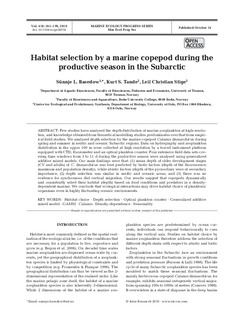Habitat selection by a marine copepod during the productive season in the Subarctic
Journal article, Peer reviewed
Permanent lenke
http://hdl.handle.net/11250/293125Utgivelsesdato
2010Metadata
Vis full innførselSamlinger
Originalversjon
Basedow, S.L., Tande, K.S. & Stige, L.C. (2010). Habitat selection by a marine copepod during the productive season in the Subarctic. Marine Ecology Progress Series, 416, 165-178. doi: 10.3354/meps08754Sammendrag
Few studies have analysed the depth distribution of marine zooplankton at high-resolution, and knowledge obtained from theoretical modelling studies predominates over that from empirical field studies. We analysed depth selection by the marine copepod Calanus finmarchicus during spring and summer in neritic and oceanic Subarctic regions. Data on hydrography and zooplankton distribution in the upper 100 m were collected at high resolution by a towed instrument platform equipped with CTD, fluorometer and an optical plankton counter. Four extensive field data sets covering time windows from 3 to 11 d during the productive season were analysed using generalized additive mixed models. Our main findings were that: (1) mean depth of older development stages (CV and adults) of C. finmarchicus was best predicted by biotic factors (depth of the fluorescence maximum and population density), while abiotic factors (depth of the pycnocline) were of secondary importance, (2) depth selection was similar in neritic and oceanic areas, and (3) there was no evidence for synchronous diel vertical migration. Our results suggest that copepods dynamically and consistently select their habitat (depth) based on food conditions and predators in a density-dependent manner. We conclude that ecological interactions may drive habitat choice of planktonic organisms even in highly fluctuating oceanic environments.

